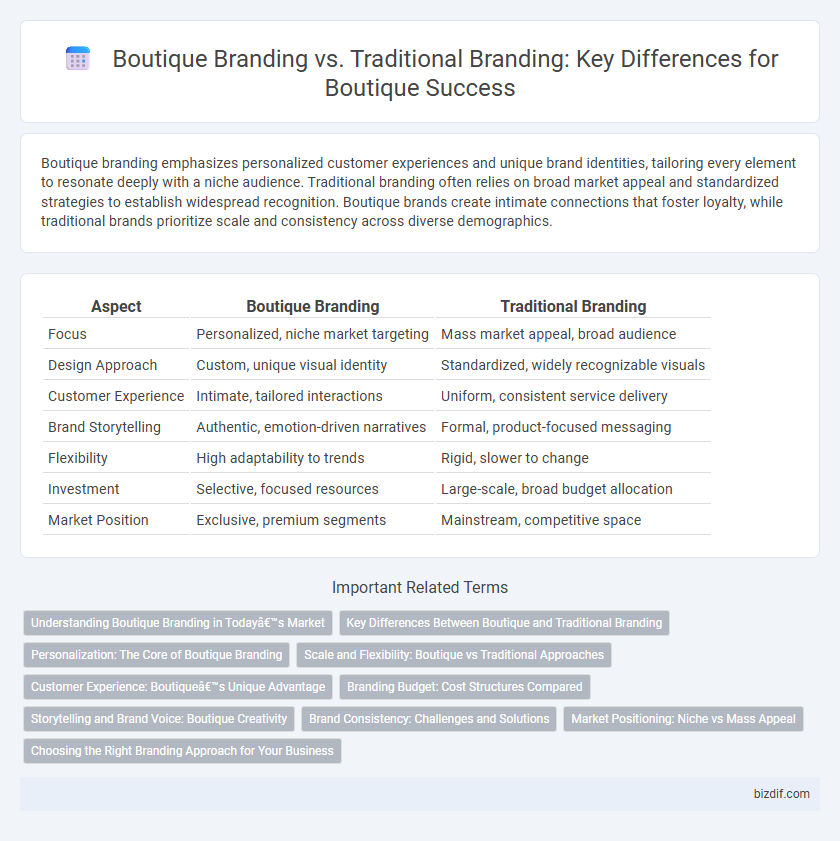Boutique branding emphasizes personalized customer experiences and unique brand identities, tailoring every element to resonate deeply with a niche audience. Traditional branding often relies on broad market appeal and standardized strategies to establish widespread recognition. Boutique brands create intimate connections that foster loyalty, while traditional brands prioritize scale and consistency across diverse demographics.
Table of Comparison
| Aspect | Boutique Branding | Traditional Branding |
|---|---|---|
| Focus | Personalized, niche market targeting | Mass market appeal, broad audience |
| Design Approach | Custom, unique visual identity | Standardized, widely recognizable visuals |
| Customer Experience | Intimate, tailored interactions | Uniform, consistent service delivery |
| Brand Storytelling | Authentic, emotion-driven narratives | Formal, product-focused messaging |
| Flexibility | High adaptability to trends | Rigid, slower to change |
| Investment | Selective, focused resources | Large-scale, broad budget allocation |
| Market Position | Exclusive, premium segments | Mainstream, competitive space |
Understanding Boutique Branding in Today’s Market
Boutique branding emphasizes personalized customer experiences and niche market targeting, differentiating itself from traditional branding's broader, mass-market approach. It leverages unique design elements, storytelling, and authentic engagement to build strong emotional connections with a specific audience. In today's market, boutique branding drives loyalty and commands premium pricing by aligning closely with consumer values and lifestyle preferences.
Key Differences Between Boutique and Traditional Branding
Boutique branding emphasizes personalized customer experiences, niche market targeting, and unique, handcrafted brand identities, contrasting with traditional branding's broad audience appeal and standardized messaging. Boutique brands leverage agile marketing strategies and emotional connections to foster strong brand loyalty, while traditional brands rely on large-scale campaigns and consistency across mass markets. The key differences lie in boutique branding's focus on exclusivity and storytelling versus traditional branding's emphasis on uniformity and widespread recognition.
Personalization: The Core of Boutique Branding
Boutique branding centers on deep personalization, tailoring every element from design to customer interaction to reflect unique client identities, unlike traditional branding, which often employs broad, one-size-fits-all strategies. This personalized approach enhances customer loyalty and emotional engagement by creating exclusive, memorable experiences that resonate on an individual level. Data-driven insights and direct feedback loops allow boutique brands to continually refine their offerings, ensuring alignment with evolving customer preferences and fostering stronger brand connections.
Scale and Flexibility: Boutique vs Traditional Approaches
Boutique branding emphasizes scalability and flexibility by tailoring strategies to niche markets, allowing rapid adaptation to evolving consumer preferences and unique brand identities. Unlike traditional branding, which relies on standardized, large-scale campaigns with fixed messaging, boutique approaches foster personalized experiences and agile pivoting to maintain relevance. This adaptability enhances brand resonance in competitive markets while optimizing resource allocation for targeted growth.
Customer Experience: Boutique’s Unique Advantage
Boutique branding offers a personalized customer experience by tailoring services and products to niche markets, fostering deeper emotional connections and loyalty compared to traditional branding's broad appeal approach. This distinct focus on customized interactions allows boutiques to provide exclusive, memorable experiences that enhance perceived value and customer satisfaction. The unique advantage lies in creating intimate brand stories that resonate profoundly with individual consumers, driving stronger engagement and word-of-mouth promotion.
Branding Budget: Cost Structures Compared
Boutique branding typically involves a flexible budget tailored to specialized services, focusing on personalized strategies and high-impact visuals, often leading to higher upfront costs but greater long-term brand equity. Traditional branding usually follows a standardized budget framework, allocating funds toward mass media advertising, broad-market campaigns, and established channels, which can be more cost-effective at scale but less agile. Comparing cost structures reveals boutique branding invests more per project with customized creative inputs, while traditional branding spreads expenses across large-volume executions and media buys.
Storytelling and Brand Voice: Boutique Creativity
Boutique branding emphasizes unique storytelling and a distinctive brand voice that resonate deeply with niche audiences, creating authentic emotional connections. This tailored approach contrasts with traditional branding's broader, more generalized messaging, resulting in a stronger sense of identity and loyalty. Boutique creativity allows brands to craft personalized narratives that highlight their values, personality, and craftsmanship, fostering meaningful engagement.
Brand Consistency: Challenges and Solutions
Boutique branding emphasizes personalized, niche market connections, but maintaining brand consistency can be challenging due to limited resources and diverse customer preferences. Traditional branding benefits from standardized processes and broad market strategies that streamline consistency across platforms. Solutions for boutique brands include implementing clear brand guidelines and leveraging digital tools to ensure cohesive messaging without sacrificing unique identity.
Market Positioning: Niche vs Mass Appeal
Boutique branding excels in niche market positioning by targeting specific customer segments with personalized and unique brand experiences, fostering strong emotional connections and higher customer loyalty. Traditional branding aims for mass appeal by promoting broad, general messages designed to attract a wide audience, often sacrificing individuality for scale. Boutique brands leverage exclusivity and tailored messaging to differentiate themselves in crowded markets, while traditional brands focus on wide-reaching visibility and consistent branding across diverse demographics.
Choosing the Right Branding Approach for Your Business
Boutique branding emphasizes personalized, niche market engagement with tailored visual identity and messaging, contrasting traditional branding's broad, mass-market strategies. Choosing the right branding approach depends on your business size, target audience specificity, and desire for exclusivity or wide recognition. A boutique approach suits businesses seeking unique differentiation and deep customer connections, while traditional branding works well for companies aiming for large-scale market penetration and brand consistency.
Boutique Branding vs Traditional Branding Infographic

 bizdif.com
bizdif.com